Constitutionally, I hail from a secular country but I am not ashamed to admit that my views were not entirely secular till recently. For me, the term “secularism” was only a method to mint votes during elections and nothing else. However, 6 months back when I took my appetite for travelling and interacting with people seriously, I was compelled to change my perceptions about the most intrinsic community of our country i.e. the Muslim Community which obviously was based on the long communal history of the country.
On my quest, I decided to explore the corners of Delhi, which are the strong base of the Muslim community. I often felt jittery and apprehensive initially but things improved as the interactions became frequent and gradually I started enjoying the whole journey of knowing the community. I will unfold my journey in a series of two encounters which enabled me to comprehend the high values of this religion and gifted me with a new outlook to see things based on real experiences.
1st Encounter- The Saint of Earthen Pot
Gripped with a mixed feeling of apprehension and inquisitiveness echoing in my head, I made myself ready for my first encounter with the community at the mausoleum famously known as “Matka Peer” or The Saint of Earthen Pot at Delhi. The first thing that one notices in this mausoleum is the numerous clay pots placed over the branches of trees, the boundary wall of the buildings and everywhere your eyes could go. These omnipresent clay pots have already puzzled my ‘dome’ by now and I was eager to know the story.
In curiosity to know more, I took a flight of steps up to small porch area of the mausoleum. Since I was a stranger to the notions and beliefs of the community, I was little timid and more vigilant of my every action and move. I washed my hands and entered the mausoleum departing from all my religious beliefs with pure heart to get introduced to an entirely new culture and religion and embrace it unbiased. I ambled in the porch area aimlessly gazing at the clay pots hung from the trees. I was feeling a bit numb at this moment as I didn’t know the way prayers were offered at mausoleum unlike temples. I didn’t desire any actions that might hurt anybody’s sentiments and spoil my first encounter. I tried to watch for other devotees so that I could follow them but unfortunately there were none at that time in the mausoleum.

While I was walking aimlessly looking out for next course of action, I was called by the priest of the mausoleum, Baba Raees, who I guess had sensed and fathomed my numbness and confusion. Baba Raees dressed in peculiar Muslim attire of Kurta-Pyzama with beautiful embroidery on the edges.
He courteously invited me inside the mausoleum for taking the blessing. He was an aged man who been serving at the mausoleum for the last 38 years, a legacy which he inherited from his ancestors continuing uninterrupted for more than 300 years now. The white beard and the curved wrinkles on his face were the indicator of his age and experience. He graciously asked my name and blessed by tapping my head and shoulders with a small bunch of peacock feathers.

Dargah of Hazrat Sheikh Abu Bakr Tusi Haidri Kalandari
On being queried about the custom of offering earthen pots at the mausoleum, he grinned a bit and gladly elaborated an interesting tale behind the tradition to calm my inquisitiveness. I could sense great pride and honour in his voice while he narrated the tale.
He also explained the lifestyle of Sufis (Muslim Saints) and how they helped the masses which somewhat resembled to life of Saints and their noble deeds in Hindu religion with which I was familiar. Albeit, Baba Raees intended to continue on the subject as he was pleased to see the curiosity coming from somebody hailing from a different religion (especially Hindu, considering communal history of country) but was obstructed by a family who had come for attaining the blessing at the mausoleum. Soon, as the number of devotees augmented at the mausoleum, he was joined by a young face, probably his son to help and take their family legacy ahead.
The interaction with Baba Raees made me little comfortable and supressed by numbness which I described earlier. It gave genesis to a new radical thought process inside me based on real experiences and encouraged me to explore it deeper.
2nd Encounter- Hazrat Nizamuddin Auliya
The edifying visit to Matka Peer (The Saint of Earthen Pot) stimulated me to amend my earlier perceptions of the community. It made me weave new ideas and opinions about this second most followed religion in the world after Christianity.
Charged with a new outlook and craving for more insights, I prepared myself for the yet another jaunt to one of the holiest places among the Muslims in world – Mausoleum of Hazrat Nizamuddin Auliya. I was accompanied by a local Muslim boy, who was the volunteer of “The Hope Project” which runs some informational tours in the area aimed at unwrapping its hidden treasures for ignorant masses like me.

A beautiful pic of the mausoleum
He took me through the twist and turns of narrow lanes of Nizamuddin Basti and showed me the enriching traditions and cultures of the Islamic community thriving in those lanes and enlightened me on various concepts of Islam which were novel to me. During the interaction, the volunteer used many typical Urdu terminologies which completely went above my “dome”, however, he was kind enough to explain them in detail.
Our nurturing walk ended at the sacrosanct mausoleum of Hazrat Nizamuddin Auliya. The holy mausoleum gladly embraces devotees irrespective of their religion. The meticulous marble structure topped by beautiful dome gleamed with numerous decorative lights and flower garlands. It was flooding with devotees from all religions and some of traditions at the mausoleum looked familiar to what I have been seeing all my life.
I saw devotees tying wishing threads like in many Hindu temples for fulfilment of their wishes. The beggars were given food like any other religious place in India. Then there was the evening prayer and everyone bowed before the almighty like in any other devotional place. At last, there were a series of Qawallis (a musical way to remember god) in the honour of almighty similar to bhajans (a term for devotional songs) in Hindu temples.

All these time, I tried to find the some substantial difference among both the Hindu and Muslim from a layman point; however, I failed to find any. All the practice though may be different in nomenclature and the manner they are performed but the ultimate purpose was absolutely same. It helped me to understand the religion and shattered most of my delusion about the religion.
By the time we finished the tour, I was taking an entirely fresh image of the community in my heart contradictory to what is portrayed in the communal history.
![]()

Kaushal Mathpal is an Advocate practicing in Delhi Courts in India but also has a flair for travelling. When he’s not in a courtroom, he enjoys exploring various parts of India and the surrounding region. He also writes on his blog http://rediscoveryourdreams.wordpress.com/ and you can follow him on Twitter @KaushalMathpal.








